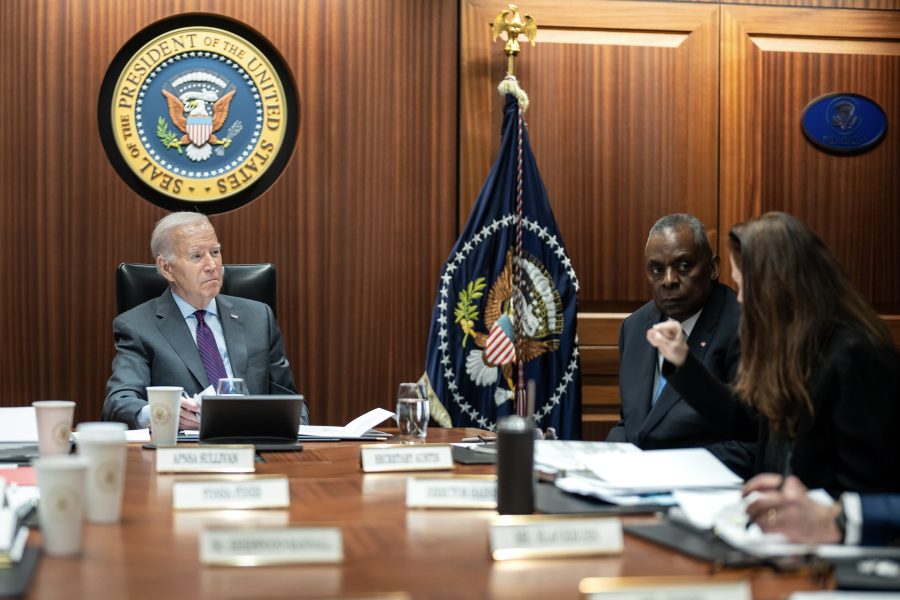The U.S. launched dozens of airstrikes against Iran’s Islamic Revolutionary Guards Corps (IRGC) Quds Force and Iranian-aligned groups in Iraq and Syria on Feb. 2, followed by more Feb. 3 against Houthi rebels in Yemen—retaliating after a drone strike killed three American service members in Jordan earlier this week.
The Jan. 28 attack on Tower 22, a small outpost in northeastern Jordan, also wounded dozens of U.S. personnel and marked a major escalation amid growing unrest in the Middle East.
In the immediate aftermath of the attack, President Joe Biden said the U.S. would respond, but offered no details. Days later, the counter strikes began hours after Biden attended a dignified transfer ceremony at Dover Air Force Base, Del., as the remains of the three Soldiers killed were returned to the United States.
In a statement, Defense Secretary Lloyd J. Austin III said the first round of strikes hit 85 targets at seven facilities. In a subsequent briefing with reporters, National Security Council spokesperson John F. Kirby said four of the facilities were in Syria and three were in Iraq.
Lt. Gen. Douglas A. Sims II, director of the Joint Staff, said fighter aircraft from U.S. Central Command and B-1 bombers flying from the continental U.S. conducted the strikes, deploying more than 125 precision-guided munitions.
“The facilities that were struck included command and control operations centers, intelligence centers, rockets, and missiles, and unmanned aerial vehicle storages, and logistics and munition supply chain facilities of militia groups and their IRGC sponsors who facilitated attacks against U.S. and Coalition forces,” a CENTCOM statement added.
Sims said the strikes appeared to be successful and all U.S. aircraft were safe.
Sims and Kirby said the decision to strike Feb. 2 was driven by the weather and a desire to avoid unnecessary casualties. Sims did say, however, that officials expected there to be militant casualties at the facilities.
In a statement from U.S. Air Forces Central, commander Lt. Gen. Alexus Grynkewich said he was “extremely proud of the discipline and professionalism with which our Airmen executed tonight’s mission. These defensive strikes highlight America’s commitment to defending our troops anytime, anywhere.”
Austin hinted at more strikes to come, following up on previous comments suggesting America would not be a passive witness to Iran-sponsored violence.
“This is the start of our response,” Austin said. “The President has directed additional actions to hold the IRGC and affiliated militias accountable for their attacks on U.S. and Coalition Forces. These will unfold at times and places of our choosing. We do not seek conflict in the Middle East or anywhere else, but the President and I will not tolerate attacks on American forces.”
U.S. and U.K. aircraft launched a second wave of strikes a day later in areas of Yemen controlled by the Houthis. All told, 36 targets were hit across 13 locations, including deeply buried weapons storage facilities, missile systems and launchers, air defense systems, and radars, the Pentagon said.
Since Hamas attacked Israel Oct. 7, prompting Israel to declare war on the group in Gaza, Iran-backed militia groups throughout the region have used ballistic missiles and drones to attack U.S. forces scores of times. That includes groups in Iraq and Syria, as well as Hezbollah in Lebanon and Houthi rebels in Yemen, which have launched dozens of attacks on commercial shipping in the Red Sea.
Yet it wasn’t until Jan. 28 that any of the attacks killed American military members. The only prior U.S. death during the present run of violence was a contractor who died from cardiac arrest while sheltering from an attack.
The U.S. had responded to those attacks with waves of targeted strikes, most recently hitting sites on Jan. 11 “associated with the Houthis’ unmanned aerial vehicle, ballistic and cruise missile, and coastal radar and air surveillance capabilities,” the Pentagon said at the time.
The U.S. struck and killed a ranking Iraqi militia figure who was implicated in planning and carrying out attacks on U.S. service personnel on Jan. 4. American forces have also launched attacks in response to direct threats to personnel.
The Feb. 2 and 3 strikes stopped short of attacking Iran itself, a step some Republican lawmakers have been calling for as a means to hold Iran accountable for the actions of its proxy and partner forces. Pentagon officials have said they hold Iran responsible for the Tower 22 attack, because Iran provided the groups weapons and training.
